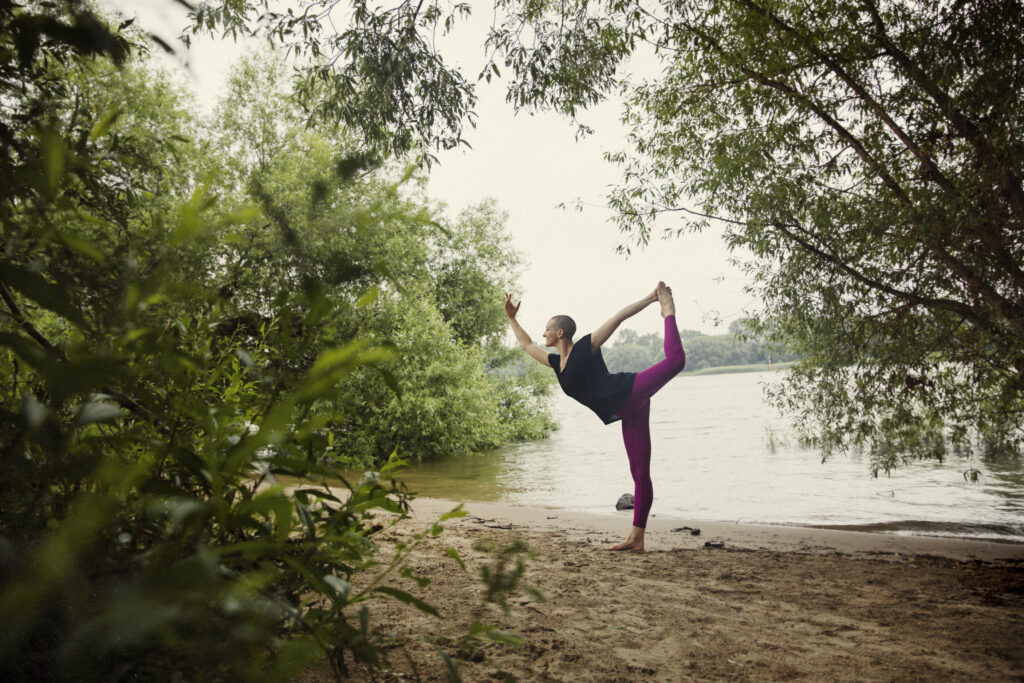 Woman in dancer pose on Rhine River bank in Cologne
Woman in dancer pose on Rhine River bank in Cologne
Natarajasana, also known as King Dancer Pose or Lord of the Dance Pose, is an inspiring and demanding Yoga Dancing Pose. This iconic asana challenges practitioners to find both courage and compassion within themselves. It’s a posture that resonates deeply within the yoga community, inviting a sense of strength and grace onto the mat.
The classical depiction of Shiva as Nataraj portrays him dancing atop a gnome, playing a drum amidst swirling dreadlocks and encircled by flames. This powerful imagery encapsulates the dynamic energy of the pose. A cobra around Shiva’s neck and a flame in his palm further enrich the symbolism.
Dancer Pose is essentially a standing balance on one leg, where the opposite foot is lifted behind, grasped by hand, while leaning forward and extending the free arm. It can be a pose that brings up feelings of vulnerability, yet it’s incredibly rewarding. This guide will explore variations and modifications to make this yoga dancing pose accessible and beneficial for everyone.
Listen to the podcast episode for more insights into Dancer Pose: Podcast 064: Daring Dancer Pose – story, strategy, & benefits of Natarajasana
Practice Natarajasana with Awareness and Caution
It is crucial to approach any yoga dancing pose, including Dancer Pose, with caution. The information provided here is based on personal experience and recommendations from respected yoga experts, not medical advice. Always consult with a healthcare professional before starting yoga or if you have any health concerns.
Mark Stephens, in Teaching Yoga, highlights the primary physical risks associated with Natarajasana as being to the “Lower back, hamstrings and knee of the standing leg, shoulders if unstable or impinging.” (Teaching Yoga Location 4,091).
Practice slowly, mindfully, and always respect your body’s signals.
Step-by-Step Guide to Dancer Pose
Jessamyn Stanley, in Every Body Yoga: Let Go of Fear, Get On the Mat, Love Your Body, explains that both supported and unsupported variations of Natarajasana are achievable. She suggests using a strap as a helpful prop: “Optional Prop: 1 strap (make a loop with your strap that’s big enough to hold your foot)” (Every Body Yoga Location 1,092). Alternatives to a yoga strap include a belt, dog leash, or towel. For balance assistance, utilize a wall, sturdy chair, or table.
Stanley’s instructions for entering Dancer Pose are as follows:
- “Starting in Mountain Pose, place your right hand on your hip for balance and bend your left knee.
- Clasp the inside or outside of your left foot with your left hand and, using the power of your leg muscles, begin lifting your thigh.
- If using a strap, hold the strap in your left hand. With your right hand on your hip for balance, bend your left knee and place your foot into the strap. Hold the strap as close to your foot as you comfortably can.
- Keep squaring your hips forward and lifting your thigh away from the floor, actively flexing your foot into the hand or strap.
- Sweep your right arm forward and up, reaching through your fingers and still continuing to lift your thigh.
- Draw your standing thigh back and soften your heart forward. Stay for a few breaths, then switch sides.” (Every Body Yoga Location: 1,094-1,102)
Stanley offers valuable tips for Dancer Pose: “Keep your hips even and neutral,” “actively press your foot into your hand or strap,” “keep a bend in your standing knee if necessary,” “press your tailbone to the floor while actively lifting your pubic bone toward your navel,” and “if you are holding on to a strap, if you have the flexibility, rotate your shoulder so that your bent elbow points to the ceiling.”
Mark Stephens in Teaching Yoga: Essential Foundations and Techniques provides slightly different cues: “From Tadasana, flex the right knee to draw the right foot up toward the right hip. Clasping the right foot with the right hand, rotate the right elbow in and up while extending the right leg back and up from the hip. Lift the left arm overhead, bend the left elbow, and clasp the right foot.” (Teaching Yoga Location 4,093-5).
Stephens emphasizes key elements for teachers and students: “Maintain pada bandha [foot lock] in the standing foot to stabilize the foot and ankle. Keep the standing leg straight and strong, avoiding locking the knee. Level the pelvis for spinal extension. Press the tailbone down, expand the chest, and draw shoulder blades forward to open the heart. If stable, release the crown of the head towards the foot’s arch and draw elbows together. Breathe!” (Teaching Yoga Location 4,096-9).
Dancer Pose Variations and Modifications
Explore these variations for a modified approach to this yoga dancing pose:
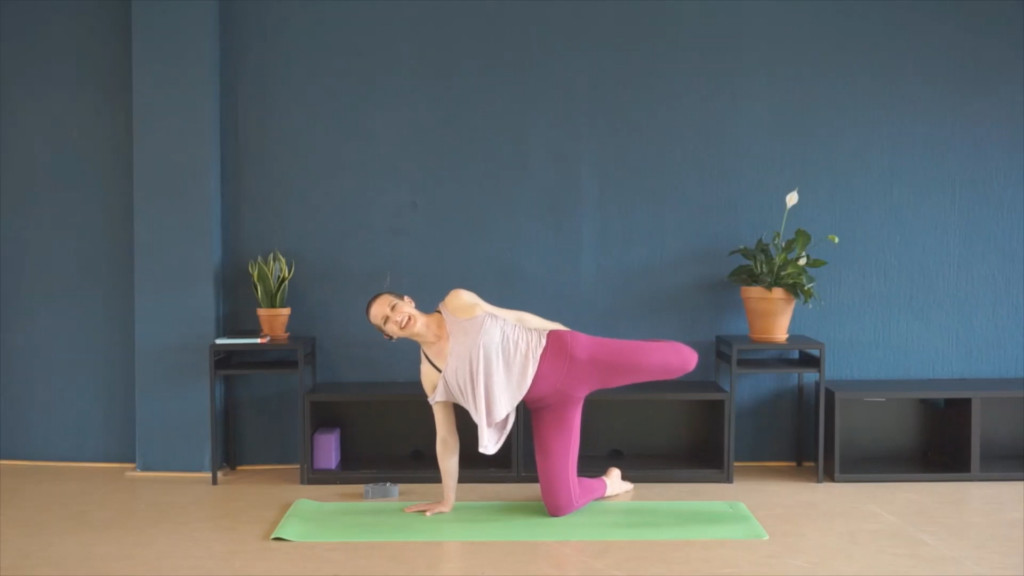 Low Side Dancer Pose Variation
Low Side Dancer Pose Variation
The “Low Side Dancer” variation offers a similar stretch and balance challenge to Natarajasana but from a different perspective. A strap can also be used for this variation.
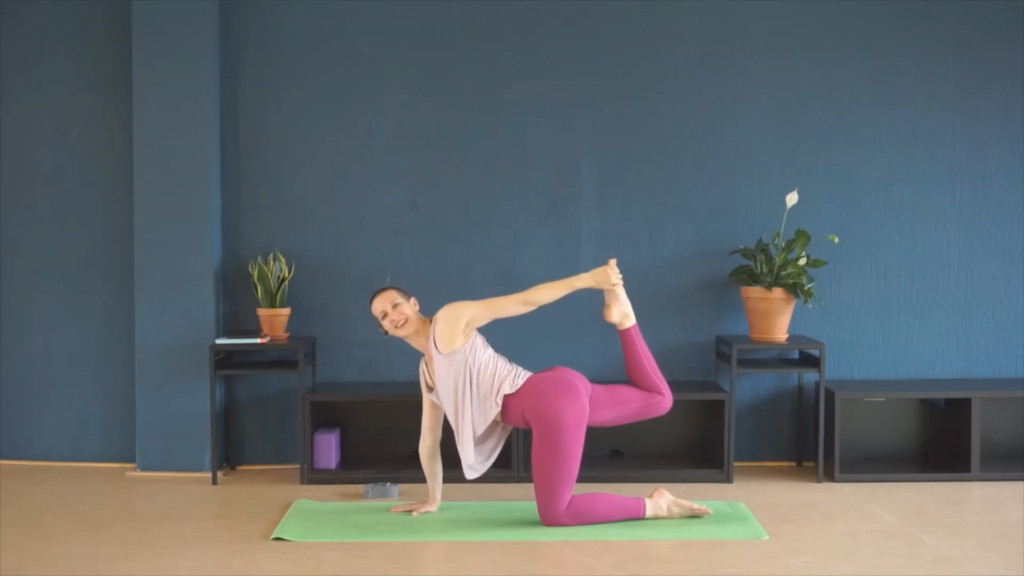 Low Twisted Dancer Pose Variation
Low Twisted Dancer Pose Variation
“Low Twisted Dancer” provides a slightly different stretch and balance challenge. A strap remains a helpful tool here.
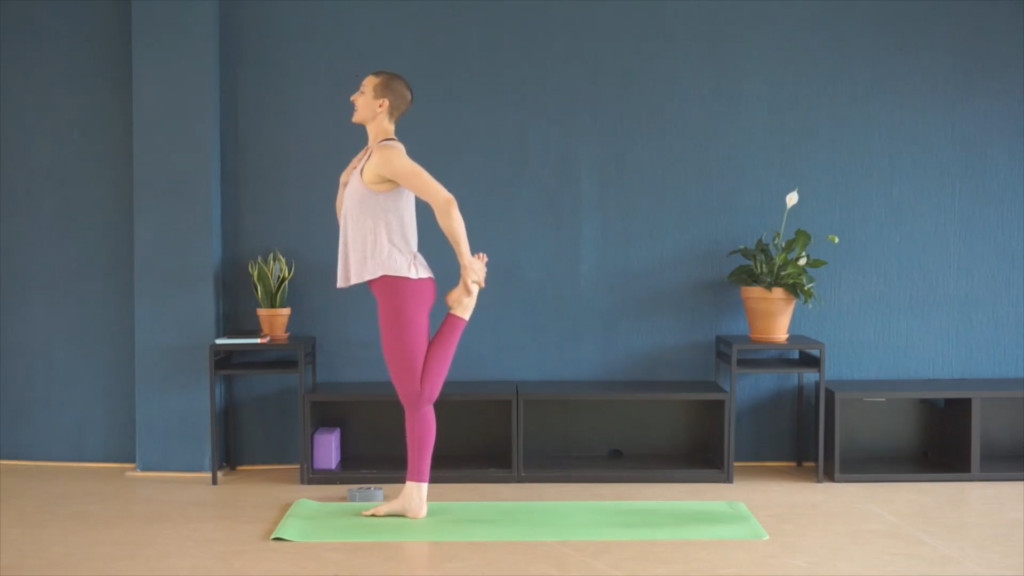 Hand to Heart Quad Stretch Variation
Hand to Heart Quad Stretch Variation
This position, the Hand-to-Heart Quad Stretch, can be used as a stepping stone to standing Dancer Pose or as a modification. It develops balance, opens the chest, and provides a gentle backbend. Straps and walls are excellent supports.
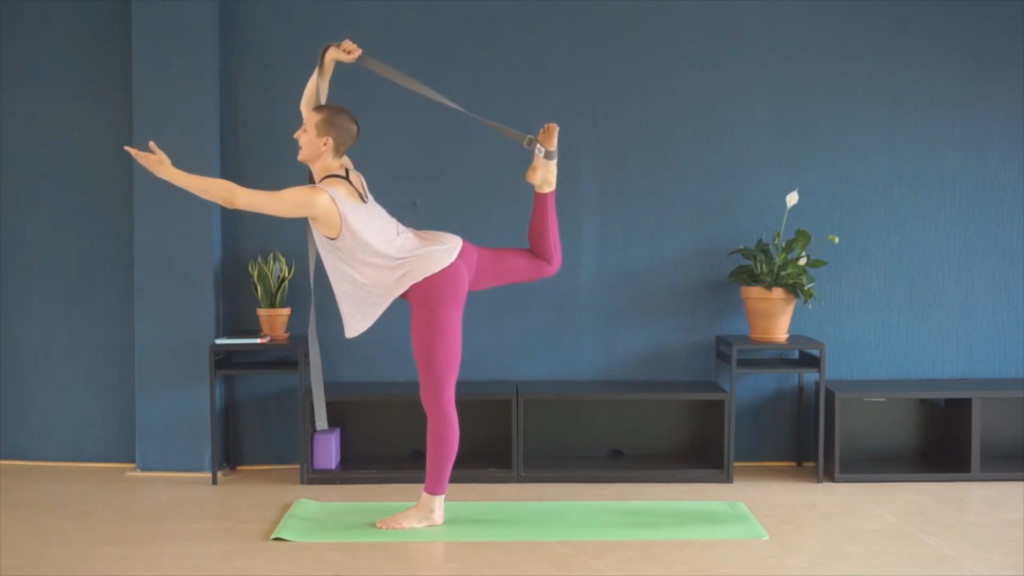 Dancer Pose with Yoga Strap
Dancer Pose with Yoga Strap
Remember to use a wall for support if needed, and pay attention to your gaze and hand position. Experiment with different hand mudras. The possibilities for variations in this yoga dancing pose are truly endless, allowing you to personalize your Dancer Pose.
Watch this 35-minute yoga flow for more Dancer Pose variations: Daring Dancer Pose Variations YouTube Video
The Story and Symbolism of Natarajasana
Understanding the origins and symbolism of Natarajasana can deepen your appreciation for this challenging yoga dancing pose. In Myths of the Asanas: The Stories at the Heart of the Yoga Tradition, Alanna Kaivalya, Shiva Rea, and Manorama explain that Nataraj is a form of Shiva, the Master Dancer who destroys and recreates the universe through his dance.
Key aspects of this myth are Shiva as King Dancer, the Cycle of Samsara, and the Illusion of Avidya. Kaivalya and Rea note, “As one of the Hindu trinity, Shiva has many different personae that illuminate his essence. The most well known is his role as the King Dancer, or in Sanskrit, Nataraja. In this guise he is commonly portrayed with snakes around his neck, dreadlocks standing on end, balancing atop a tiny dwarf, and encircled by a ring of fire.” (Myths of the Asanas Location: 537-539).
The ring of fire, samsara, symbolizes the cycle of birth, life, and death. “Shiva dances to his own music within a circle of flame known as samsara. Samsara is the cyclical pattern in which we are all stuck—the constant repetition of birth, life, and death.” (Myths of the Asanas Location: 544-5).
The cobra around Nataraj’s neck represents avidya, “The poison the cobra carries symbolizes the toxic nature of avidya, the misunderstanding of ourselves as something other than divine. He has found the remedy to that affliction, which is enlightened knowledge, and he carries its symbolic flame in one of his palms.” (Myths of the Asanas Location: 550-1 emphasis mine).
Lessons Learned from Dancer Pose
Practicing Dancer Pose offers valuable lessons both on and off the mat.
Kaivalya and Rea explain how the physical demands of Dancer Pose connect to our mental and emotional boundaries: “Natarajasana allows us to experience a couple of physical elements that can bring about fear in our bodies. Backbending and balancing both elicit fear because of the openness and bravery they require. We tend to store fear in our heart (according to the chakra system), and when we open the heart, we give ourselves an opportunity to let go of fear. Likewise, balancing gives us an opportunity to overcome our natural fear of falling and to be brave and free.” (Myths of the Asanas Location: 576-8).
Dancer Pose challenges us with both balance and backbending, elements that individually and combined can evoke fear. Yoga practice helps us gradually expand our comfort zones by developing stability, balance, and flexibility.
Even experienced dancers may find Dancer Pose challenging. Personal limitations, whether physical or mental, are universal. Yoga practice cultivates awareness and skill in navigating these challenges.
Dancers and athletes can particularly benefit from the physical and mental discipline of Dancer Pose. Overcoming the internal and external challenges of this yoga dancing pose builds courage and resilience.
The myth of Nataraj and the experience of practicing Dancer Pose encourage us to face fears, embrace change, and release attachments, ultimately revealing our true nature.
Spiritual Benefits of Natarajasana Practice
On a deeper level, Dancer Pose introduces us to avidya and abhinivesha, concepts from yoga philosophy. Kaivalya and Rea describe: “In the Yoga Sutra, Patanjali outlines five obstacles that prevent us from true freedom, which are called the kleshas. The first is avidya, and the fifth and most powerful obstacle is the fear of death, or abhinivesha. Death is the ultimate change and takes many forms in our lives, until the greatest death of all, which comes at the end. As the lord of death and destruction, Shiva understands that change, even one as great as death, is really the only constant in the universe.” (Myths of the Asanas Location: 566-7).
Yoga cultivates a crucial life skill: navigating change. This involves self-awareness and self-knowledge gained through self-reflection and meditation. Dianne Bondy and Kat Heagberg in Yoga Where You Are emphasize “Compassionate self-study offers a path to meet yourself without judgement, just where you are and just how you are.” (p.212).
Compassionate self-study occurs through meditation, journaling, and mindful yoga practice. Explore reflective journaling in Reflective Practice through Journaling in Dance, Yoga & Life and meditation practices in the 2021 Meditation Practice Challenge blog.
Ultimately, yoga seeks greater freedom – freedom of movement, courage, and compassion.
“In order to dance like Shiva, we must feel free. Freedom comes from knowing there is nothing that binds us permanently. Shiva’s dance is born out of a liberation from the fear of change. He teaches us to ride the wave of change as if we’re on a cosmic surfboard, coasting toward the shore of bliss.” (Myths of the Asanas Location: 564-5).
Questions for Reflection
- What obstacles have you identified for practicing Dancer Pose?
- What modifications or variations help you access the pose?
- What yoga poses or movements do you find especially challenging in general?
- What emotions come up for you in these times of challenge?
- What modifications or variations can help you access the potential benefits of these poses, movements, or activities?
- How can I or another trusted teacher support your practice?
Blythe Stephens, MFA & Bliss Catalystshe/her or they/them
A Blythe Coach: Dance Education & Coaching move through life with balance, grace, & power
DISCLAIMER: A Blythe Coach recommends that you consult your physician regarding the applicability of any recommendations and follow all safety instructions before beginning any exercise program. When participating in any exercise or exercise program, there is the possibility of physical injury. If you engage in this exercise or exercise program, you agree that you do so at your own risk, are voluntarily participating in these activities, assume all risk of injury to yourself.
